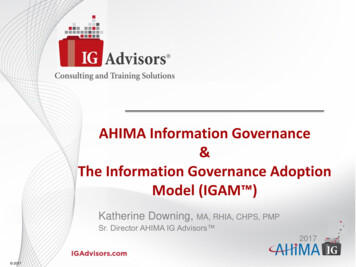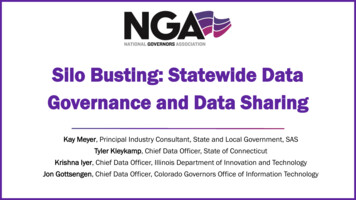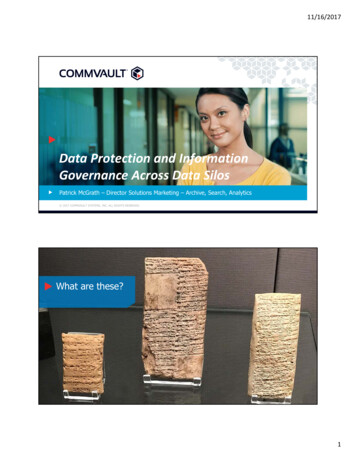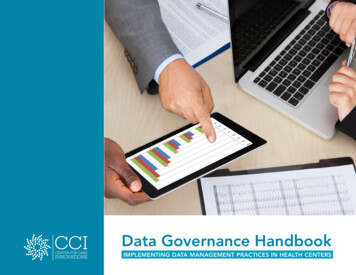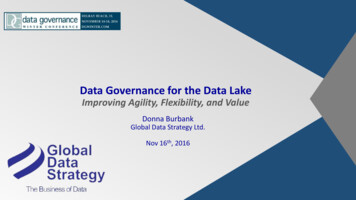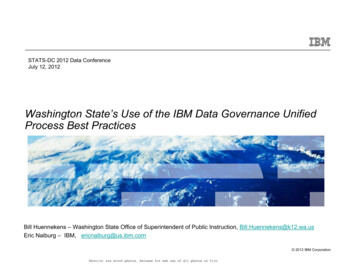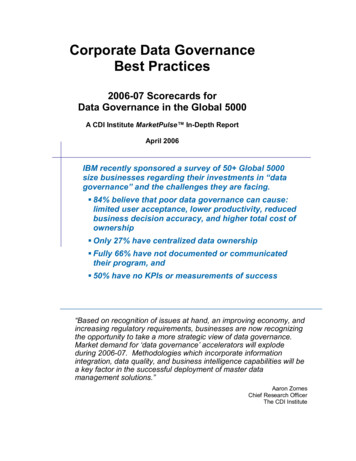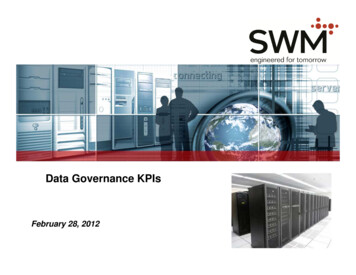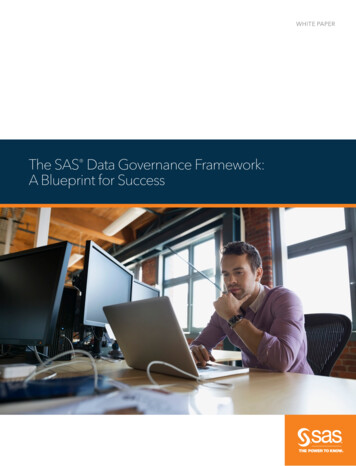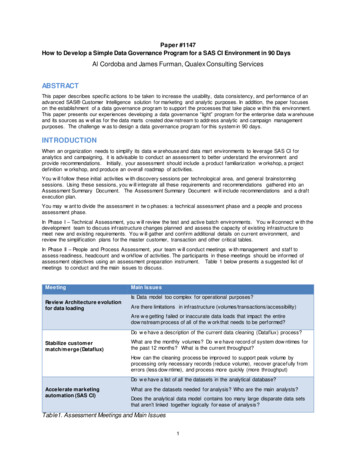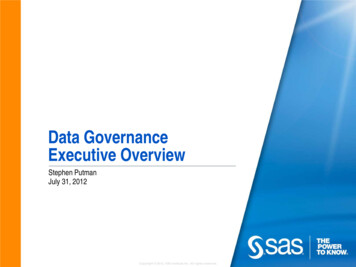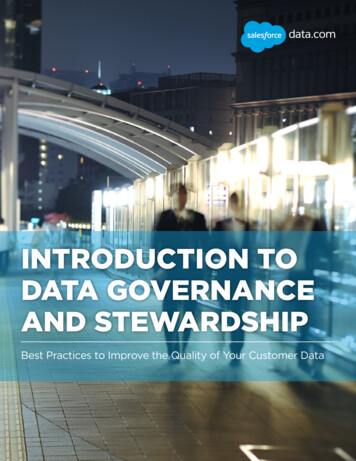
Transcription
INTRODUCTION TODATA GOVERNANCEAND STEWARDSHIPBest Practices to Improve the Quality of Your Customer Data
Why Data Governance and Stewardship?3Devoting resources to data quality pays dividends1: Assess the State of Your Data4Four questions to help gauge data quality and usage2: Develop Your Governance Plan73: Implement Your Governance Plan10How to create a plan that suits your businessSetting the table for reliable data stewardshipConclusion 152
Why data governance and stewardship?With all the time and effort put into creatinga centralized source of customer informationcomes the challenge of making sure this datais put to good use across the company. Andit is a big challenge. Irrelevant or inaccuratedata reduces employee productivity, hamperscustomer engagement, and can give yourcompetition the upper hand.Typical data issues, such as incomplete records,out-of-date or obsolete information, andduplicates, erode trust in enterprise systemsand affect key business functions. To realize thefull value of technology investments like theSalesforce platform, you need to have policiesand processes in place to make sure you’recollecting the right data, managing it effectively,and ensuring that it is reliable and relevant.This is where data governance and stewardshipcome into the picture. 700 700 billion a year inThe right framework for handling data will notonly make the job of the data steward moreefficient, but it also serves to keep marketingand sales efforts running smoothly: C ustomer data drives campaign and sales strategy,helping you get the most from your resources. T he ability to target customers reliably and effectivelycreates an advantage over the competition. B etter data improves finance, customer service andsupport, and operational functions, which meansincreased customer satisfaction.Simply put, the right data allows you tounderstand, adapt, focus, and execute withsurgical precision. Creating a governance andstewardship plan helps care for your data, sothat it becomes an asset instead of a liability.In this paper, we’ll show you how to get startedby assessing the current state of your data, andthen building a framework for governance. We’llalso describe the key stewardship activities youshould consider to make data an integral part ofyour organization.potential sales is lost due to bad data.1GovernanceDefining the TermsWhile many might assume that governanceand stewardship are synonymous, there arenuances that are important to understand.Establishes rules and policies to ensure reliableand effective customer data. These rules defineprocesses and protocol to ensure usability,quality, and policy compliance of the data asset.StewardshipPuts tactical roles and activities into effectto ensure adherence and support of the datagovernance plan. It includes assigning peopleto uphold the plan, and developing strategy formonitoring and maintenance of customer data.3
Chapter OneASSESS THE STATEOF YOUR DATABefore developing a governance and stewardship plan, it’s important thatyou gain a deep understanding of the current condition of data in yourorganization. Some key questions and research will clarify where you’ll need tofocus your energy initially, as well as where you can improve in the future. It’salso important to understand how data is or is not managed, so you can helpeliminate bad behaviors and promote best practices. A few simple questionswill allow you to assess your organization’s current approach to data.
1Who is usingcustomer data?2What are the businessneeds for data?3Which data is usedthe most?Get a clear idea of who uses customer informationwithin your organization, so you can provide datathat best suits their needs. Run reports to see whocreated and last modified data, as well as how oftenthey are viewing it. Make note of where users accessdata, since it’s important to understand how differentteams put data to use.Before becoming mired in technical needs andprocess, it’s important to think about and discussbusiness needs and priorities for data. You can gethelpful data quality information by going straightto those who use it most. This includes simpleshadowing of users, discussions, or even pollingthem for specific pain points and thoughts onprocesses. Talk to end users to understand dataneeds within different departments, and to discoverissues that governance and stewardship can address.Learning what users know now, what they need toknow, and what they wish they knew will help identifygaps and map future goals.As you look at your CRM system, check which fieldsare most complete for each record type and whichfields are most frequently modified. This will helpidentify which data is actually being used.Next, it’s important to find out what users are doingwith that data. Are they sending it to other systems,warehouses, or applications? For each data field,which business tasks and processes does it informon a regular basis? For example, do opportunityvalues get extracted to another location to helpdrive sales commission numbers?40%40%of all business initiativesfail to achieve their targetedbenefits due to poordata quality.25
4How is the databeing used?Not every use of data is fully tracked by technology.Users can offer information on when they export,manipulate, or load data, and how they make use of itfrom there. Hold more interviews to identify data that isrelevant for these uses. Map out these processes in orderto know how future changes may impact these users.TIP: Create a data quality score thatmeasures key attributes to identifydata that needs attention.Measuring Your Data QualityReview and segment data based on the followingattributes that determine quality and usefulness:Age: Time elapsed since date last modifiedCompleteness: Percentage of records that includekey data fieldsUsage: Time since last used in reports orother applicationsAccuracy: Matches against a trusted sourceConsistency: Field formatting and spelling is thesame across records (state or province, phone, country,and so on)Duplication:Amount of identical or very similarrecords that vary in quality6
Chapter TwoDEVELOP YOURGOVERNANCE PLANNow that you’ve assessed the current state of your data, you have a solidgroundwork for putting together a data governance plan. Consider thefollowing as sections or pieces of the plan. The key, always, is to maintaina balance between protocol and flexibility, and to empower users to feel asense of ownership of data standards and quality.
Data DefinitionsDevelop and apply standards for naming and organizingdata. Consider how data is captured or entered into thedatabase, and then create a workflow for verifying andapproving records as they enter the system. Define thestages a record passes through during its lifetime; makesure to give thought to business usage and which groupsown certain kinds of data, even down to the field level,when developing definitions. Also, define data types —including master, reference, and transactional — to beapplied in usage, permissions, and stewardship activities.Quality StandardsSet appropriate standards for data quality, including theability to measure or score records. As you did in yourassessment, put a value on age, completeness, usage,accuracy, consistency, and duplication, along with anyother quality or value metrics specific to your business.With an emphasis on the sustainability of your plan,think about how you can incorporate visible data qualitymeasurements within your applications to help userssupport the standards.Account RecordCreation: LockedDown or Open?Many companies lock down accountcreation to maintain data quality,meaning any new account record mustbegin with a request to data stewards.But the larger the company, the moreunwieldy this process becomes. Amore flexible and informed creationprocess allows end users to enter oramend a record after searching theorganization’s existing data, as wellas a third-party reference to find themost accurate and complete record.Meanwhile, technology that blockscreation of duplicates or alerts anadmin when duplicate records areentered help give data stewardsthe control and confidence to deliverdata quality without having toimpose restrictions.For different types of records, define the must-haveand optional information. For example, lead recordscould require name, email, account or company, title,and country, while optional fields might include phone,address, company size, and department or job function.8
Roles & OwnershipTeam members involved in governance and stewardshipshould know their roles, the time that’s allotted for thiswork, and how they’ll be held responsible. Detail wheredecision-making power resides for the different types ofdata in your system. Consider the RACI model to outlinewho is:ResponsibleAccountableConsultedowns the datamust sign off on or approve changescan provide information and supportInformed needs to be notified, but not consultedSecurity & PermissionsAssign consistent and appropriate levels of privacy,confidentiality, and verified access to comply withregulatory, legal, and contractual obligations. Outlinewhich fields are most relevant for different groups ofusers, and which need to be restricted or hidden. Notethat your data access requirements may look slightlydifferent than your actual organizational hierarchy.Quality Control ProcessThis last section of your governance plan focuses onthe stewardship function. Outline the structure of aquality control process, including frequency, scope,owners, and checks. Include methods for cleansing,de-duping, blocking duplicates, merging, and adding torecords. Create a policy for data retention and archival,supported by metrics that can be tracked usingsimple dashboards.How Master DataManagement Tools ImproveSalesforce PerformanceMaster Data Management (MDM)focuses on the consistency of dataacross systems and applications.MDM tools provide: Record creation assistance Record maintenance across systems Integration management R egulatory and complianceenforcement Enterprise-wide visibilitySalesforce’s open API platform isdesigned from the ground up toeasily work with MDM tools. Manyorganizations make Salesforce theircustomer master in order to takeadvantage of the platform’s security,flexibility, and cloud-based scalability.Follow the 80/20 RuleDon’t get bogged down in pursuitof 100% accurate data; instead, firstfocus on high-value records to getthe most from your investment.Often, companies using Salesforcefind the traditional 80/20 ruleapplies to their data, meaning 80%of their revenue can be tied backto 20% of their customer database.Determine the 20% of data that ismost valuable to the organization,making sure that your governanceplan focuses on improving thatdata before tackling the remaininginformation in your CRM.9
Chapter ThreeIMPLEMENT YOURGOVERNANCE PLANCreating a well-informed data governance plan is an important step toward gettingthe most from your customer information. But a system is only as strong as thosewho carry it out. The everyday stewards of your data must apply these policiesgoing forward. At the same time, it’s crucial to stress the importance of caring fordata across your organization. Stewardship includes assigning the parts each teammember and each departmental group has to play in improving customer data, andfinding ways to ensure that it remains strong long after the initial push. Here are thekey aspects of data stewardship.
Make data entry andmanagement easy.To get the most out of your data, you need to encourageusers to make sure any and all customer informationis entered correctly into the system. This starts withan easy-to-use data entry interface, and dashboardsor scoring methods that provide metrics showing thedata’s value. In order to motivate your users to takepart in data stewardship, make sure you establish goalsthat are reachable and easily tracked. Consider addinga field to records with an icon or score to display itsquality. This can also encourage users to add detail orinclude additional data from a trusted source. Look intoways you can reduce free-form data entry with toolsthat enter information quickly and easily. An automateddata-acquisition strategy that makes use of trusteddata providers reduces entry errors, resulting in morestandardized, complete information.What Can I Manage Internally vsRelying on Data Providers?Many companies spend significant time and resourcesgathering data, such as industry information, thatthird-party data partners are better prepared toprovide. Determine which data to manage internallyand which can be outsourced.Internally sourced: Proprietary financial data Legally sensitive data, like social security or payment numbers Data unique to your organization, such as internal product SKUsExternally sourced: Business card data Company profiles and locations Industry classification details Corporate hierarchy mapping11
Keep data lean and effectivewith regular housekeeping.It’s important to keep only current and relevant data in thesystem to realize its full value. Plan for data cleanups ona regular basis and create a schedule. There are five basicsteps to cleansing your data:STEP1STEP2Standardize your data.Making sure data fields are uniform takes someeffort, but it will make a big difference whensearching and segmenting records. The mostcommon problems are formatting differences,such as the inconsistent use of country andstate fields. You can resolve these differencesautomatically with the Mass Update Addressestool. Make sure to update the country first, andthen state. Other standardization tasks includedealing with the most common spelling mistakes,addressing area code issues, resolving ISO(country) code confusion, and removing inaccuratevalues. The use of pick lists for standard fields(state, country, and so on) will help to eliminatemanual errors at the point of entry.Eliminate duplicates.Start by examining duplicates across recor
Why data governance and stewardship? Before developing a governance and stewardship plan, it’s important that you gain a deep understanding of the current condition of data in your organization. Some key questions and research will clarify where you’ll need to focus your energy initially, as well as where you can improve in the future. It’s also important to understand how data is or is .
